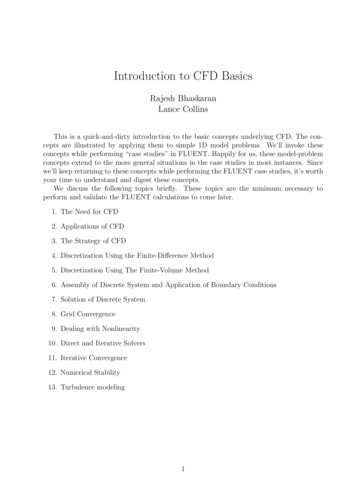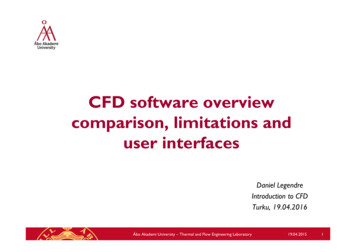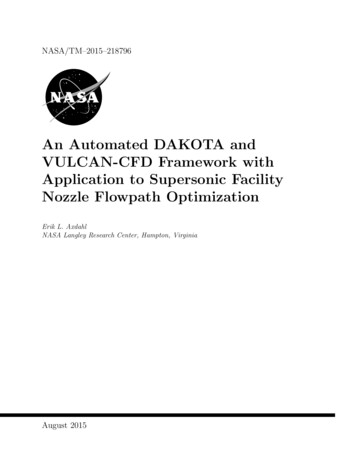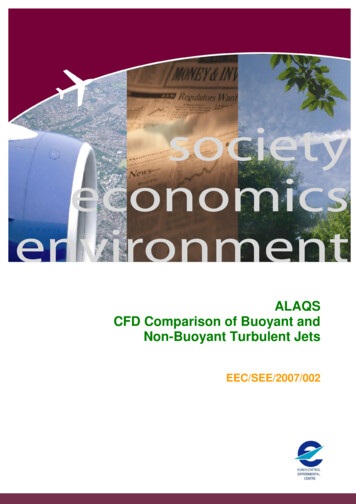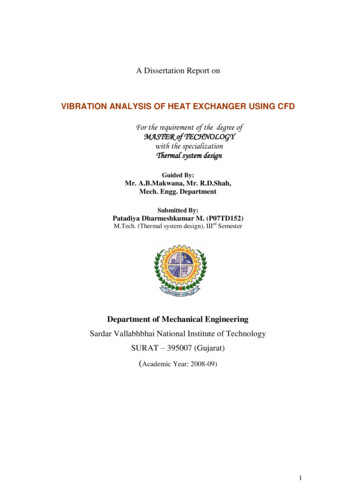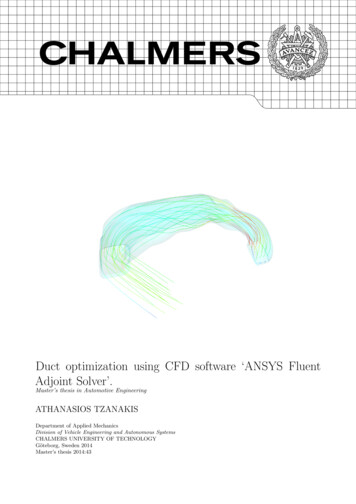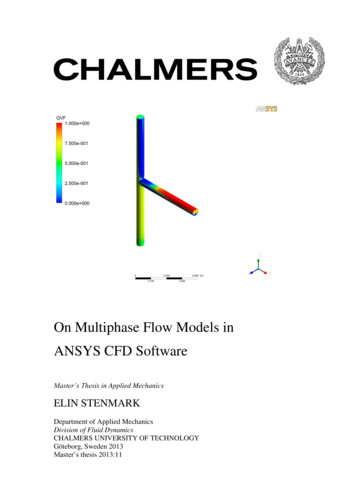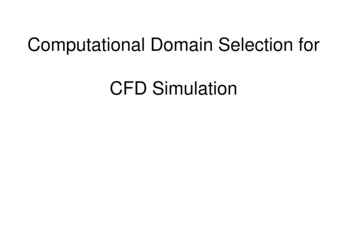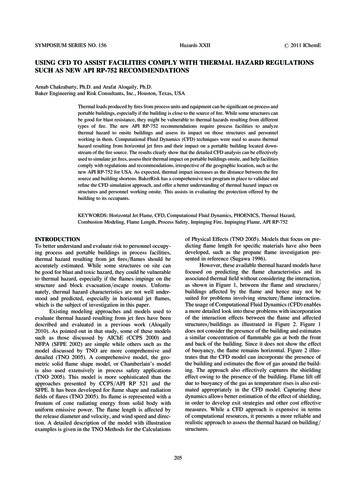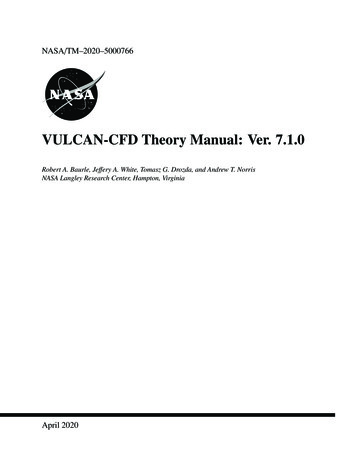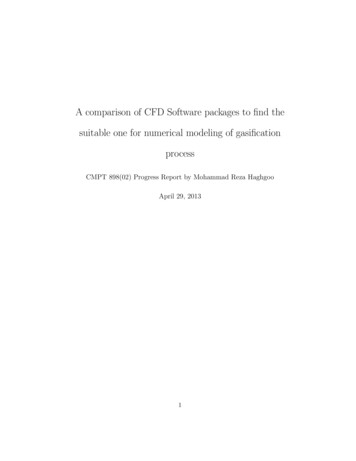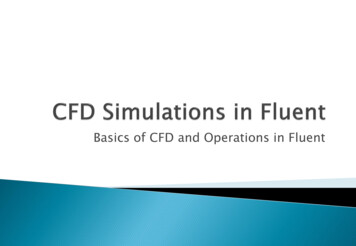
Transcription
Basics of CFD and Operations in Fluent
Basic concepts of Numerical Calculations Pre-processing in Fluent Solutions Post processing in Fluent Programming: Journaling, Scripting, UDF
Analytical vs. Numerical Approach
Analytical Calculation vs. Numerical Calculation Analytical Results Available as explicit or implicit form of an equation such as a quadratic equation. It is a continuous equation, available at each point is space (Infinite Unknowns)Numerical Calculation Available at discrete location in space / time dimensions (Finite Unknowns) It is an inherently discontinuous approach with some averaging / blending to ensurephysical correctness Examples Simply supported beam - Analytical Plate temperature distribution - Numerical
Analytical Calculation vs. Numerical CalculationNumerical solution:Approximate solution of theactual problemNumerical solution:Approximate solution of theapproximate problemP x3 3 xL2 2 L3 x6 EIAnalytical solution: Exactsolution of the approximateproblem
Traditional vs Virtual Design EvaluationsTraditional Design MethodologyModern Design tual PrototypesPhysical PrototypesVirtual TestingDesign ChangesPhysical TestingCAX:Physical PrototypeCAD, CAE,CFD, CAADesign ChangesPhysical Testing Long Product Development Cycle Minimal Prototypes and Cost Effective Many prototypes Product Development Cycle Drastically Reduced Very Costly Better Insight into various Design Aspects
Typical Flow Chart for Numerical AnalysisDefine Input / Output - Assumptions based on Engg. JudgmentPrepare CAD Model, De-featuring & Simplification for CFD meshingPre-processingGenerate Mesh and Define Zones / Patches – inlet, outlet, wall, symmetry Define Thermodynamic and Transport Properties of MaterialSpecify Boundary and Initial ConditionSelect flow model: Laminar, Turbulent, Single-phase, Multi-phase Solver Setting &SolutionSelect appropriate turbulence model based on flow type, wall functionSpecify discretization schemes, time steps Analysis Run: Batch Mode (command line), GUI, Remote ServerContour Plots, Velocity Vectors, Streamlines, Pathlines, Isolines Post-processingAnimations for Streamlines, Particle Tracks, Coefficients of Pressure Report Preparation
Local Server: GUI-operations and their meaning
Starting Fluent1. 2D or 3D, single precision or doubleprecision (dp - double precision)2. Pre-processing, Solution and Post Process[Full Simulation] or just post-processing
Setting of Mouse Button for PAN (MOVE) – ZOOM – ROTATEBasic SettingsThe probe option with print the informationwhen clicked inside mesh
Reading Mesh: File Import Mesh, Read Case FileGUI MenuSelect as appropriate
Reading Mesh: File Import Mesh, Read Case Top panel describes the summary of case fileGUI MenuTUI MenuSoftware operation summary. Note ‘done’ atthe end! Any error will be reported here.
Check Mesh: Grid CheckCheck at the bottom forerror message
Check Mesh: Repair Shadow Zones in Periodic MeshWARNING: node on face thread 2 has multiple shadows.This warning message appears only in case of periodic (translational of rotational)faces!These faces can be repaired only through the Text User Terminal (TUI)TUI: grid modify-zones repair-periodic1. The program will automatically try to detect theperiodic distance or angles though will ask to userinputs as well2. The command can be shortened as: grid mz rp
Manipulate Mesh: Optional for ease of simulation1. Merging Zones: combining multiple zones of similar type – process not fullyreversible (de-merging to previous state not possible): keep back-ups2. Separating Zones: Opposite of “Merging Zones” – required if say there aremultiple outlets and all grouped into single zone in the meshing software.3. Creating Periodic Zones, Slitting Periodic Zones: For periodic zones4. Scaling the Grid – FLUENT is a metric solver. Scale the mesh appropriately toconvert into meters. E.g. if mesh was generated in inch, scale factor 0.02545. Translating the Grid: Move the grid in required to move near origin6. Rotating the Grid: Rotate the mesh to orient to particular axis
Manipulate Mesh: Optional for ease of simulationSome other options for the sake of completeness1. Fusing Face Zones: fuse boundaries (and merge duplicate nodes and faces)created by assembling multiple mesh regions.2. Slitting Face Zones: Not same as separating a face zone! Slit an internal wall orcoupled wall zone into two distinct uncoupled zones.3. Extruding Face Zones: A face can be extruded to increase the domain size saychanging location of the outlet to prevent reverse flow.4. Replacing, Deleting, Deactivating, and Activating Zones5. Reordering the Domain and Zones
Manipulate Mesh: Separate Face ZonesThis feature is most used among all the options described earlier
Apply Boundary ConditionsBoundaries are representation of physical state of the computational domain!Zones defined by CFD AnalystBoundary condition typeavailable in FLUENT
Define Material PropertiesThermodynamic and transport properties of all the phasesThermodynamics propertiesTransport properties
Define Turbulence ModelRANS: Reynolds-Averaged Navier Stokes and k-e are the workhorse of industry!Turbulence ModelsWall Function
Solver running, monitor and convergenceparammeters
Define Solution LimitsIf during computation value exceed these limits, solver will clip to range defined.Limits of mean valuesLimits of fluctuating values
Define Initial Values: solve Initialize Initialize A better guess helps improve the convergence sometimes!Based on selected boundaryCalculated value
Define Convergence Criteria: Solve Monitors Residual When the solver should stop running? Either criterion-1 or criterion-2 is met!Criterion-1Print in the console and plotas graphical chartCriterion-2
Qualitative plots, quantitative integration andaveraging
Display Contour Plots: Display Contours Contour: coloured representation of field variables on a plane or surfaceCriterion-1How to show the plot andinterpolate the results?Number of sub-divisions inlegend
Display Vectors: Display Vectors Vectors field represented as arrowsCriterion-1Range of plot and scale,whether to show mesh?Vector scale and spatialdistribution
Volumetric heat source, temperature dependentmaterial properties
UDF: User-Defined Function, Journals and Transcripts1. FLUENT uses programming languages SCHEME (TUI), FORTRAN(back-endmathematics) and Tcl/Tk (GUI)2. UDF: FLUENT is a general-purpose CFD simulation program and cannotaddress all the physical variations. UDF fills this gap.3. Journals and Transcripts are similar recording of VBA scripts in EXCEL.4. The details of this feature is covered under advance topic once you getmastery of the topics covered so far!
Please visit http://www.cfdyna.com for exploremore about CFD and related stuff.You may write to me at amod.cfd@gmail.com toget help on any advance topic!
Basics of CFD and Operations in Fluent . multiple outlets and all grouped into single zone in the meshing software. 3. Creating Periodic Zones, Slitting Periodic Zones: For periodic zones 4. Scaling the Grid – FLUENT is a metric solver. Scale the mesh appropriately to convert into meters. E.g. if mesh was generated in inch, scale factor 0.0254 5. Translating the Grid: Move the grid in .
